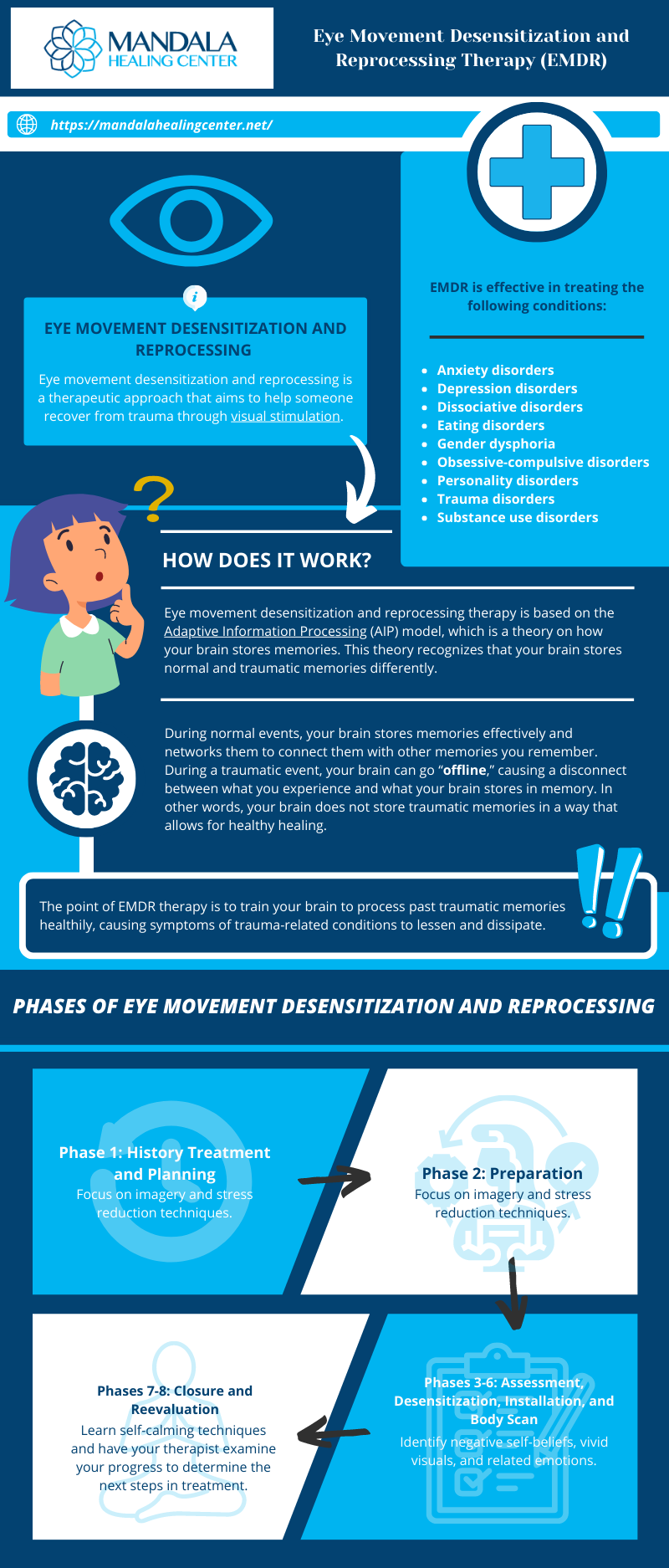Addiction is a chronic and progressive disease that requires extensive treatment and dedication to maintain long-term recovery. There are many different approaches to treating addiction, with varied forms of therapy being effective in providing positive results. One of the best therapies for substance abuse is known as eye movement desensitization and reprocessing (EMDR) therapy.
While EMDR is typically used to treat post-traumatic stress disorder (PTSD) and other trauma-related conditions, addiction experts have realized the connection between substance abuse and trauma. Nearly half of people who struggle with addiction also suffer from PTSD.[1]
Since many recovering addicts have a history of trauma and often suffer from the effects of trauma, EMDR is commonly used in addiction treatment programs.

What is Eye Movement Desensitization and Reprocessing (EMDR) Therapy?
Eye movement desensitization and reprocessing is a therapeutic approach that aims to help someone recover from trauma through visual stimulation.
Experts found a connection between the rhythm of a person’s eye movements and the association of traumatic memory. Asking a patient to recall a traumatic memory while stimulating their vision can help the brain reprocess how that memory is stored, reducing any intense feelings associated with that memory.
EMDR is effective in treating the following conditions:
- Anxiety disorders
- Depression disorders
- Dissociative disorders
- Eating disorders
- Gender dysphoria
- Obsessive-compulsive disorders
- Personality disorders
- Trauma disorders
- Substance use disorders
EMDR can treat a wide range of mental health conditions, however, they must be stemming from traumatic experiences. If you or a loved one experienced something traumatic before developing a substance use disorder, EMDR therapy might be right for you.
How Does Eye Movement Desensitization and Reprocessing (EMDR) Work?
Eye movement desensitization and reprocessing therapy is based on the Adaptive Information Processing (AIP) model, which is a theory on how your brain stores memories.[2] This theory recognizes that your brain stores normal and traumatic memories differently.
During normal events, your brain stores memories effectively and networks them to connect them with other memories you remember. During a traumatic event, your brain can go “offline,” causing a disconnect between what you experience and what your brain stores in memory. In other words, your brain does not store traumatic memories in a way that allows for healthy healing.
The point of EMDR therapy is to train your brain to process past traumatic memories healthily, causing symptoms of trauma-related conditions to lessen and dissipate. How long EMDR treatment lasts will depend on how much trauma you have to process. Someone with one singular traumatic event might only attend treatment for 3 to 6 sessions, while a person with multiple traumas might require up to 12 sessions.
It is important to note that while this type of therapy requires you to remember traumatic events, you do not have to go into specific details. Therapists who conduct this type of therapy are experienced in helping patients recall traumatic memories in a manner that prevents retraumatization and keeps them feeling safe and comfortable.
How Does EMDR Help Treat Addiction?
A large majority of the people who suffer from addiction have a history of trauma. According to the National Child Traumatic Stress Network, “one in four children and adolescents in the United States experiences at least one potentially traumatic event before the age of 16.”[3] Even further, about 70% of adolescents receiving addiction treatment have experienced trauma in the past.
Because trauma often causes people to seek out forms of self-medication through drugs and alcohol, it is often the root cause of addiction. As a result, trauma therapy is a vital aspect of addiction recovery for many individuals and EMDR therapy is considered an effective treatment for substance use disorder. By treating the trauma that preceded the addiction, your compulsion to abuse substances will lessen.
During EMDR, there are 8 phases of treatment. Phase 1 involves identifying emotional distress, phase 2 focuses on imagery and stress reduction techniques, and phases 3 through 6 have you identify negative self-beliefs, vivid visuals, and related emotions. In phases 7 and 8, you will seek self-calming techniques and the therapist examines your progress.
Eye movement desensitization and reprocessing can provide you with the following benefits:
- Reduced symptoms of PTSD
- Decreased feelings of anxiety and depression
- Learning how to manage triggers related to your addiction
- Improved coping skills
- Increased self-esteem
Find a Trauma-Informed Addiction Treatment Program Today
If you or a loved one suffer from a substance use disorder, help is available. Oftentimes, addiction is caused by experiencing a traumatic event and not knowing how to cope effectively. Attending a drug and alcohol rehab center that offers EMDR and other types of trauma therapy can help you recover from past traumas and reduce compulsions related to substance abuse.
The Mandala Healing Center is committed to treating each person as a whole, integrating a healthy lifestyle that will help our patients truly heal from the inside out. At the core of healing is exceptional clinical care. Our dynamic addiction treatment methods provide a foundation for life-long recovery through addressing the underlying causes of suffering in today’s families. Our patients are empowered to reclaim their lives and restore their health, free from addiction and substance misuse.
To learn more about our South Florida recovery program or to start your recovery, please contact us today.
References:












